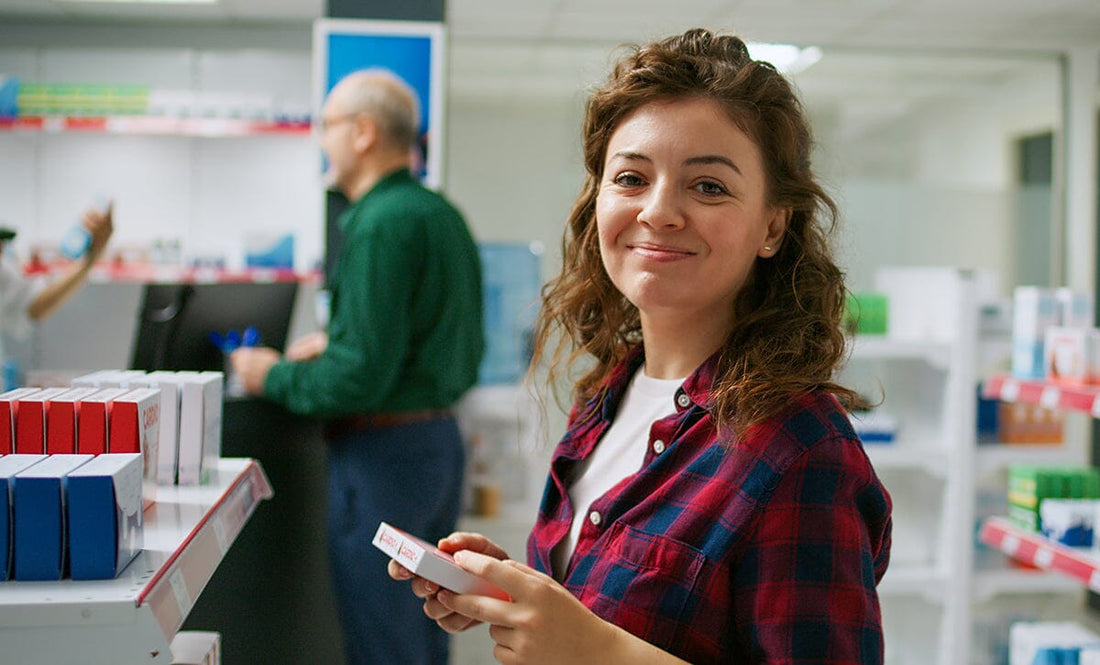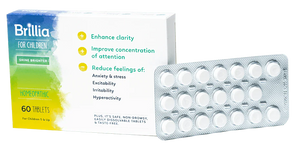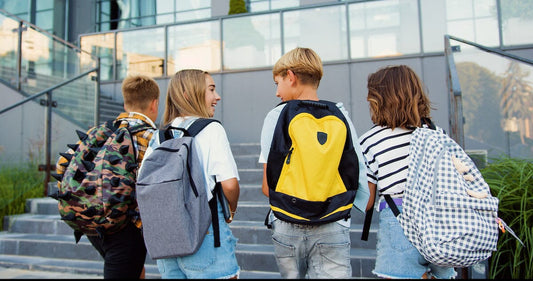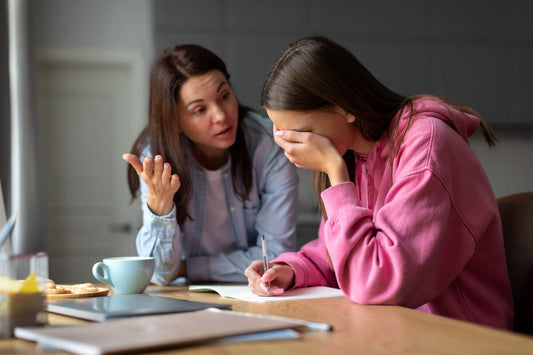OTC ADHD Medicine & Alternatives for Kids
Recent stats from the CDC show that 1 out of 20 of all U.S. children takes medication for ADHD.1 The drugs consist of prescription stimulants like Ritalin® and Adderall®, non-stimulants like Strattera® and Intuniv®, and even SSRIs like Lexapro® and Zoloft®.
While these medications are helpful for many, they do carry a number of side effects that lead many to consider non-prescription alternatives. Read on to learn more about non-prescription ADHD medication and supplements for kids, lifestyle habits that can help reduce symptoms, and how to choose the right path for your child.
Diagnosing ADHD in Kids
To receive an ADHD diagnosis, your child’s pediatrician will evaluate them based on the standard guidelines established in the DSM-5.2 They’ll typically wait until the child is over four years old before evaluating.
There are three types of ADHD: primarily hyperactive/impulsive, primarily inattentive, or combined type. According to DSM-5, your child may be diagnosed with ADHD if they have six or more symptoms of inattention/hyperactivity for at least six months, or six or more symptoms of inattention. Their symptoms must interfere with daily life and be present in two or more settings, such as at school and home. Other mental health disorders cannot justify the symptoms.
Symptoms of ADHD vary in every child, but they may include:
- Difficulty paying attention
- Failure to respond when spoken to directly
- Makes careless mistakes on schoolwork
- Difficulty following instructions
- Frequently loses items
- Distractibility
- Forgetfulness
- Constant fidgeting
- Inability to stay in their seat
- Talks excessively
- Interrupts others
- Difficulty waiting their turn
How is ADHD Typically Treated for Children?
Behavioral therapy is often one of the first recommended treatments for ADHD, especially in children younger than six. This type of treatment aims to help kids with ADHD learn or strengthen positive behaviors and stop unwanted or problem behaviors.
For children six and older, the American Academy of Pediatrics recommends a combination of medication and therapy.3 This may include prescription or non-prescription medication.
OTC vs. Prescription ADHD Medication for Kids
At Brillia, we see the value in prescription ADHD medication for kids and know that these types of products have helped many children control their symptoms and perform better academically, socially, and emotionally. However, we suggest seeing such medications as a last resort, rather than the first and only option. After all, the CDC admits that the long-term effects of ADHD medications on young children have not been well-studied and side effects tend to be more severe on children.
Using a combined approach of behavioral therapy, lifestyle changes, and non-prescription medication presents an appealing alternative to prescription drugs for your child. And if they still need more support after these gentler routes have been exhausted, prescription medication is still an option.
Common Types of OTC ADHD Medications and Supplements for ADHD
From homeopathic medication to nutritional supplements, there are a number of non-prescription options that can help reduce ADHD symptoms and improve your child’s focus. Read on to find out more about how they work.
Brillia
Brillia is a homeopathic medication clinically proven to reduce symptoms like inattention, hyperactivity, impulsivity, and restlessness. Suitable for children 5-18, the medication targets the brain-specific S100B protein, a key regulator of many different intracellular and extracellular brain processes, including interneuronal communication and neuroplasticity. Studies show that variations of S100B are associated with a range of neuropsychiatric diseases and stress-induced ailments.4 Brillia normalizes this protein, which gently and effectively alleviates undesirable ADHD symptoms without affecting any other systems in the body. This means that taking Brillia will not make your child drowsy, dizzy, nauseous, and it won’t affect their appetite. There are also no contraindications associated with the medication, so you can add it to their regimen even if they are already taking prescription medication or supplements.
Besides the active ingredient, another thing that makes Brillia unique is our holistic approach. Just as the CDC recommends combining behavioral therapy with medication, we recommend behavioral changes to maximize Brillia’s success. Our holistic 5 Pillars outlines science-backed lifestyle habits that have been proven to reduce symptoms of ADHD, such as proper nutrition, adequate sleep, controlled screen time, and mindfulness. These habits teach your child how to manage their symptoms on their own while Brillia provides support. Over time, as these lifestyle habits become automatic, your child will need less and less of the medication, although they can continue taking Brilia as long as it is working. Find out more about how this holistic strategy works.
L-Theanine
Found naturally in green tea, L-Theanine is a water-soluble amino acid that is considered one of the top Adderall alternatives. It has been shown to enhance concentration and improve impulsivity, especially when combined with caffeine.5 It is also said to have a calming effect to reduce stress and anxiety, which often co-occurs with ADHD.6
B Vitamins
B vitamins are critical to brain function and have been well documented as a potential treatment for ADHD. Studies show that supplementing with B vitamins can significantly reduce symptoms of hyperactivity, inattention, and aggressiveness and may produce even stronger results when combined with magnesium.7 Low B levels have also been associated with ADHD diagnoses and higher symptom severity.8
Omega-3s
Omega-3 fatty acids have a number of health benefits, including lowering the risk of heart disease and reducing inflammation. There is also extensive research showing that they can enhance cognitive function and reduce symptoms of ADHD. Studies show omega-3s may help improve focus and task completion.9 They can also help reduce symptoms of hyperactivity, impulsivity, restlessness, and aggression in children.
Explore other vitamins and supplements that may help reduce ADHD symptoms in kids.
What Other Alternatives Can Help Ease ADHD Symptoms?
As stated above, Brillia relies on a holistic approach to help ease symptoms of ADHD. These include the following behavioral strategies.
Reduced Screen Time
While screens are a big part of modern life, spending too much time on them can cause big problems for kids with ADHD. In fact, some studies show that too much screen time may even lead to behavior that mimics ADHD symptoms like inattention, poor task completion, and hyperactivity.10 Even more, screen time can interfere with sleep, which leads to fatigue and irritability and can exacerbate ADHD symptoms. Taking steps to minimize screen time can help control your child’s symptoms and spend their time more constructively. Get ideas here.
Mindfulness
Practicing mindfulness is another way your child can learn how to self-regulate and control their symptoms. Studies show that mindfulness significantly improves symptoms of inattention, hyperactivity, and stress, while improving focus in adolescents.11 While expecting your child to sit in meditation for an extended period of time may seem daunting, there are a variety of other mindfulness techniques they can learn, including deep breathing exercises or even yoga. Get ideas here.
Nutritional Diet
Two of the supplements we mentioned above–B vitamins and omega 3s–can easily be found in foods like fish, poultry, legumes, seeds, and more. Eating a well-rounded diet will help your child obtain these nutrients and a variety of others to support a healthy brain and body. Get ideas here.
Quality Sleep
We mentioned that the effects of screen time can mimic ADHD symptoms, but so can the effects of not getting enough sleep. Both tiredness and ADHD impact executive functioning, making it difficult to pay attention, follow directions, remember information, and stay organized. Make sure your child gets 8-11 hours of sleep every night. It may seem like a luxury to a busy adult, but it’s imperative for all children with growing brains. Get ideas here.
Key Ingredients to Look for in OTC ADHD Medication or Supplements
When examining the label of a supplement or OTC ADHD medication for your child, be on the lookout for harsh, synthetic chemicals (often identifiable by words that are difficult to pronounce), as well as fillers and additives like artificial colors or artificial flavors.
Also keep in mind that most dietary supplements are not regulated by the FDA. Homeopathic non-prescription medications like Brillia are actually regulated differently than other drug products. Homeopathic medications are required to provide substantive documentation with clinical trials and studies of the claims that the product makes, abide by FDA standards and regulations (e.g., for quality and labeling), and go through a proper registration process detailing active ingredients and inactive ingredients in order to be allowed to be sold in the U.S. You can be sure that what you see on the Brillia label is what you’re getting in the product.
Choosing the Right Route for Your Child
No two children experience their ADHD symptoms in the same way. In the same sense, no two children will respond to treatments in the same way. If you’re ever unsure which route to take, consulting with your child’s pediatrician is an important first step. Asking a therapist, counselor, ADHD coach, or even your child’s teacher can also help you gather enough resources so you can make a thoroughly informed decision when choosing the right route for your child.
Find out more about how Brillia works and explore more resources on how to help your child with ADHD at the Brillia(nce) Resource Center.
Get a whole bunch of support right in your inbox.







